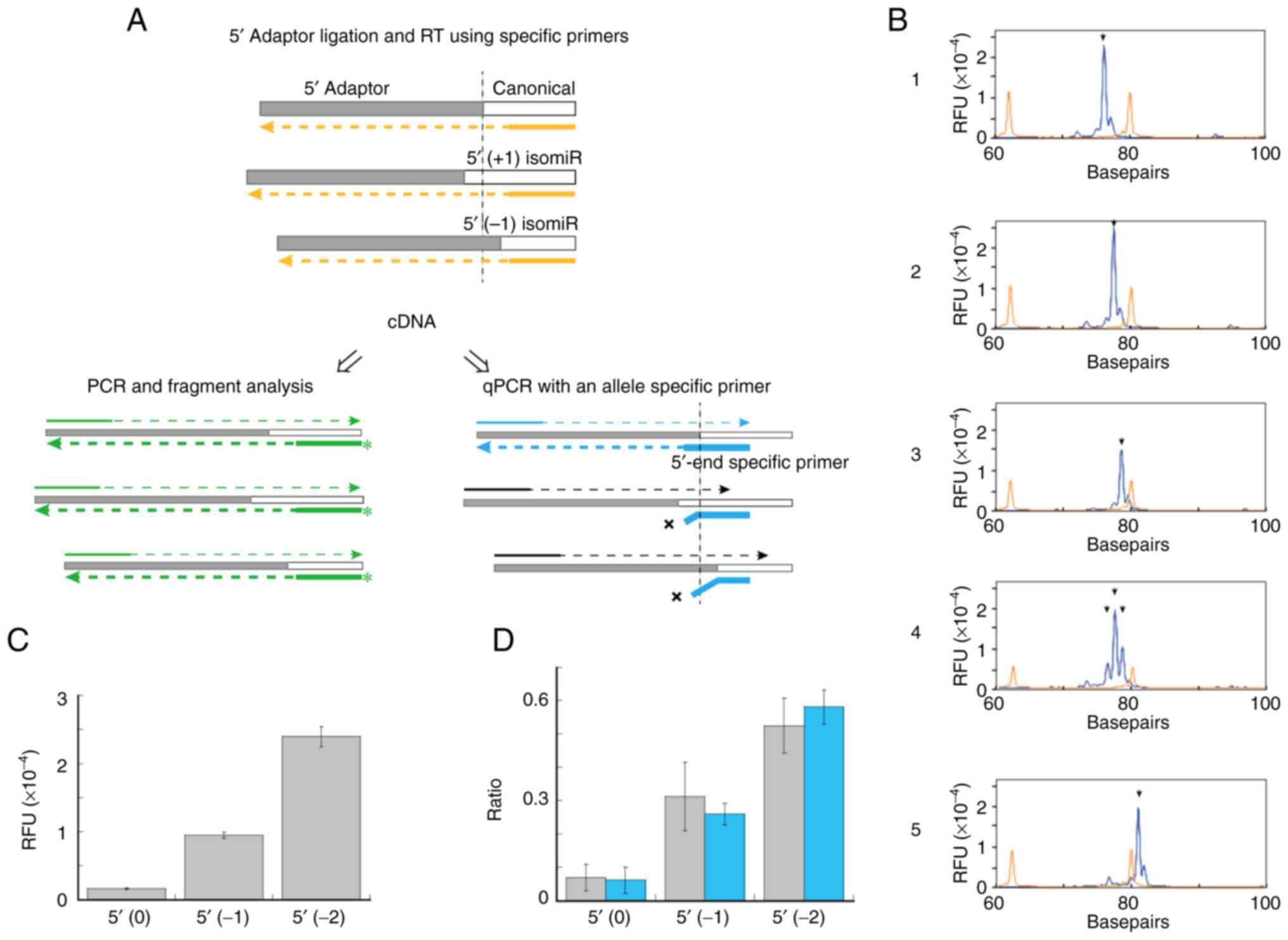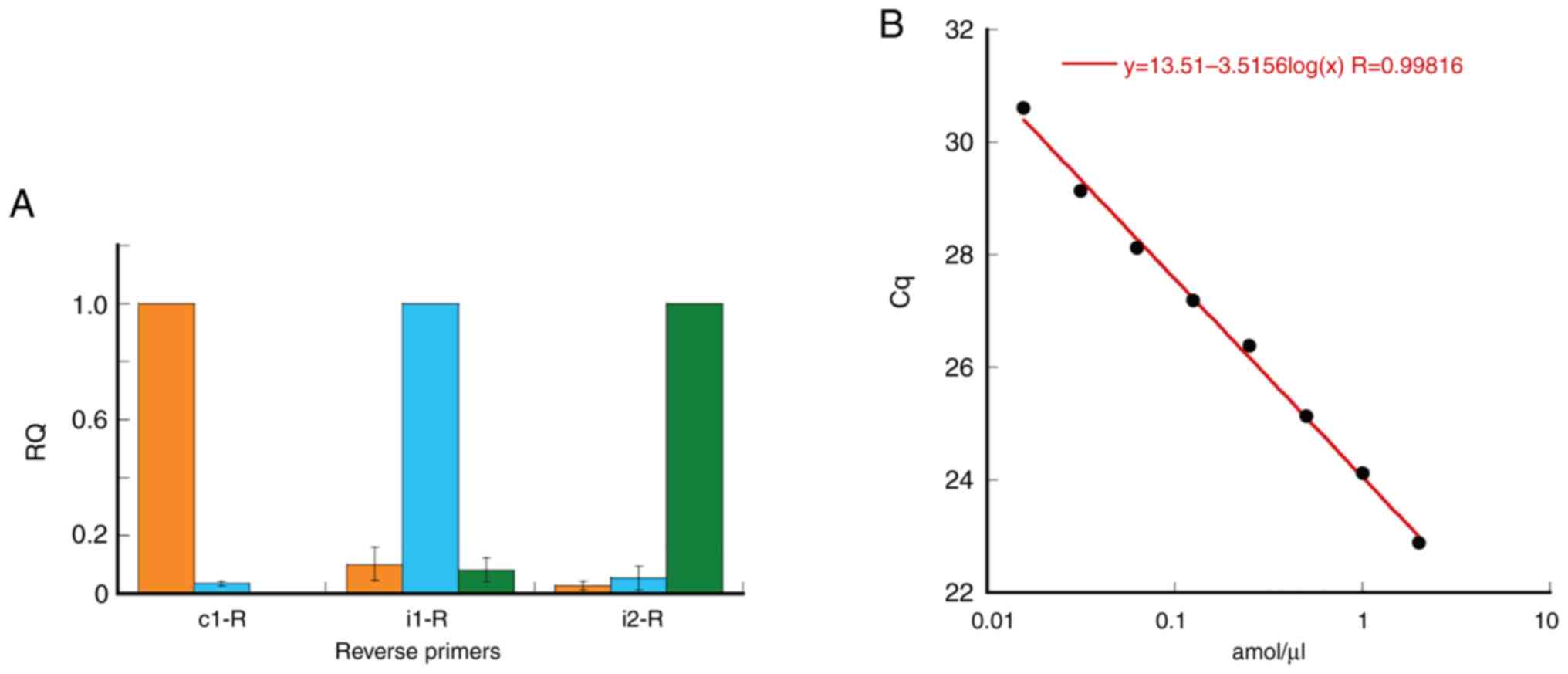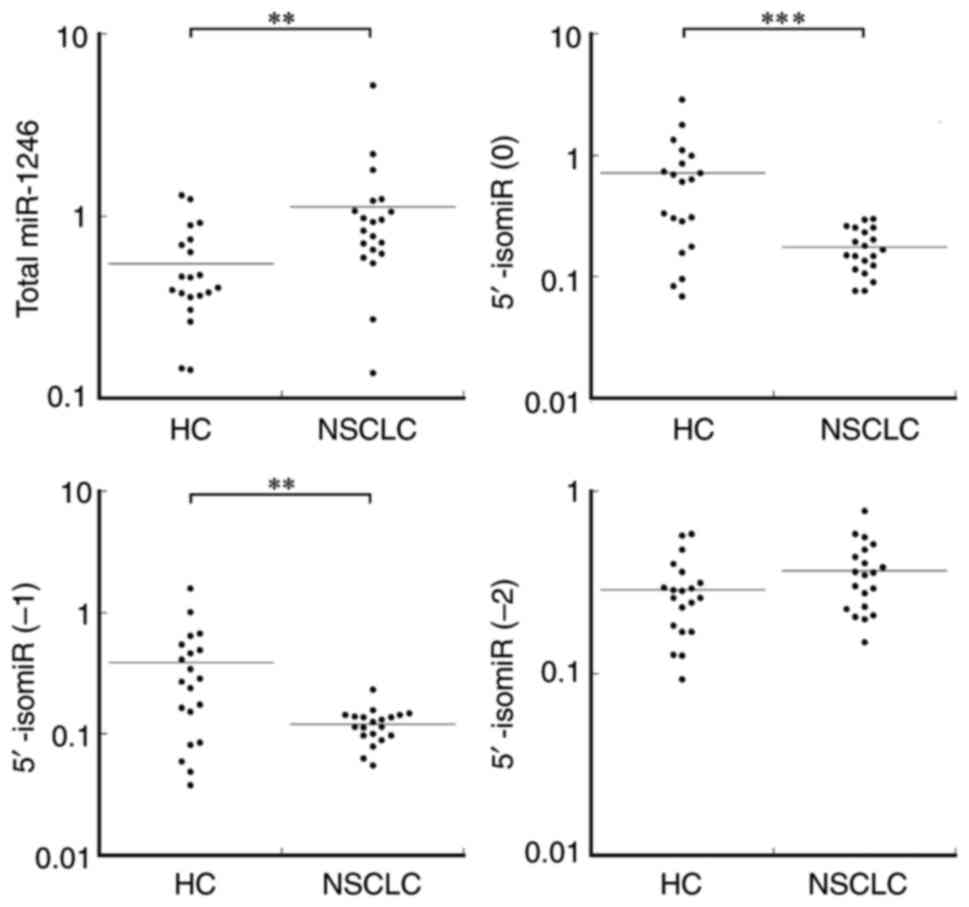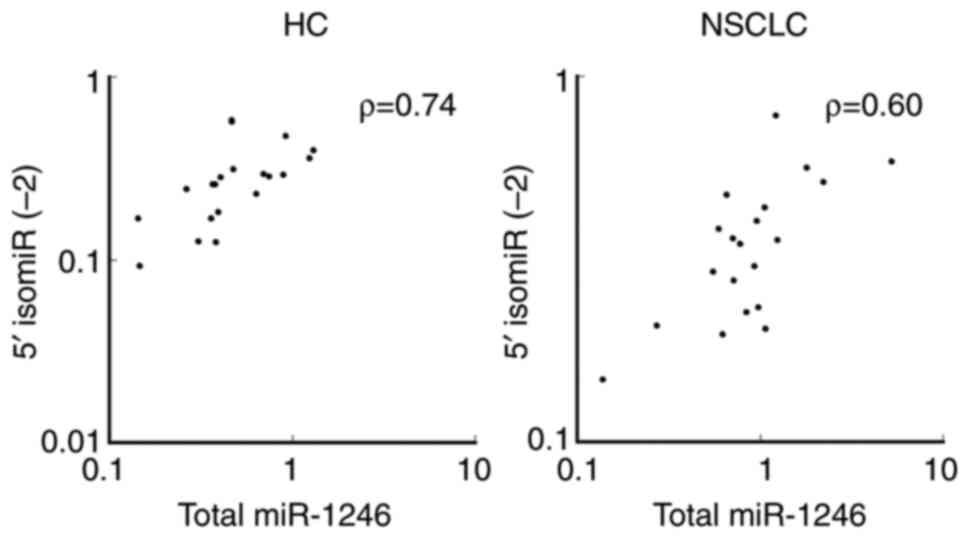|
1
|
Landgraf P, Rusu M, Sheridan R, Sewer A,
Iovino N, Aravin A, Pfeffer S, Rice A, Kamphorst AO, Landthaler M,
et al: A mammalian microRNA expression atlas based on small RNA
library sequencing. Cell. 129:1401–1414. 2007. View Article : Google Scholar : PubMed/NCBI
|
|
2
|
Morin RD, O'Connor MD, Griffith M,
Kuchenbauer F, Delaney A, Prabhu AL, Zhao Y, McDonald H, Zeng T,
Hirst M, et al: Application of massively parallel sequencing to
microRNA profiling and discovery in human embryonic stem cells.
Genome Res. 18:610–621. 2008. View Article : Google Scholar : PubMed/NCBI
|
|
3
|
Lee LW, Zhang S, Etheridge A, Ma L, Martin
D, Galas D and Wang K: Complexity of the microRNA repertoire
revealed by next-generation sequencing. RNA. 16:2170–2180. 2010.
View Article : Google Scholar : PubMed/NCBI
|
|
4
|
Burroughs AM, Ando Y, De Hoon MJL, Tomaru
Y, Suzuki H, Hayashizaki Y and Daub CO: Deep-sequencing of human
argonaute-associated small RNAs provides insight into miRNA sorting
and reveals argonaute association with RNA fragments of diverse
origin. RNA Biol. 8:158–177. 2011. View Article : Google Scholar : PubMed/NCBI
|
|
5
|
Xia J and Zhang W: A meta-analysis
revealed insights into the sources, conservation and impact of
microRNA 5′-isoforms in four model species. Nucleic Acids Res.
42:1427–1441. 2014. View Article : Google Scholar : PubMed/NCBI
|
|
6
|
Juzenas S, Venkatesh G, Hübenthal M,
Hoeppner MP, Du ZG, Paulsen M, Rosenstiel P, Senger P,
Hofmann-Apitius M, Keller A, et al: A comprehensive, cell specific
microRNA catalogue of human peripheral blood. Nucleic Acids Res.
45:9290–9301. 2017. View Article : Google Scholar : PubMed/NCBI
|
|
7
|
Rubio M, Bustamante M, Hernandez-Ferrer C,
Fernandez-Orth D, Pantano L, Sarria Y, Piqué-Borras M, Vellve K,
Agramunt S, Carreras R, et al: Circulating miRNAs, isomiRs and
small RNA clusters in human plasma and breast milk. PLoS One.
13:e01935272018. View Article : Google Scholar : PubMed/NCBI
|
|
8
|
Karlsen TA, Aae TF and Brinchmann JE:
Robust profiling of microRNAs and isomiRs in human plasma exosomes
across 46 individuals. Sci Rep. 9:199992019. View Article : Google Scholar : PubMed/NCBI
|
|
9
|
Koppers-Lalic D, Hackenberg M, De Menezes
R, Misovic B, Wachalska M, Geldof A, Zini N, De Reijke T, Wurdinger
T, Vis A, et al: Non-invasive prostate cancer detection by
measuring miRNA variants (isomiRs) in urine extracellular vesicles.
Oncotarget. 7:22566–22578. 2016. View Article : Google Scholar : PubMed/NCBI
|
|
10
|
Mjelle R, Sellæg K, Sætrom P, Thommesen L,
Sjursen W and Hofsli E: Identification of metastasis-associated
microRNAs in serum from rectal cancer patients. Oncotarget.
8:90077–90089. 2017. View Article : Google Scholar : PubMed/NCBI
|
|
11
|
Guo L and Chen F: A challenge for miRNA:
Multiple isomiRs in miRNAomics. Gene. 544:1–7. 2014. View Article : Google Scholar : PubMed/NCBI
|
|
12
|
McCall MN, Kim MS, Adil M, Patil AH, Lu Y,
Mitchell CJ, Leal-Rojas P, Xu J, Kumar M, Dawson VL, et al: Toward
the human cellular microRNAome. Genome Res. 27:1769–1781. 2017.
View Article : Google Scholar : PubMed/NCBI
|
|
13
|
Neilsen CT, Goodall GJ and Bracken CP:
IsomiRs-the overlooked repertoire in the dynamic microRNAome.
Trends Genet. 28:544–549. 2012. View Article : Google Scholar : PubMed/NCBI
|
|
14
|
Liang T, Yu J, Liu C and Guo L: IsomiR
expression patterns in canonical and dicer-independent microRNAs.
Mol Med Rep. 15:1071–1078. 2017. View Article : Google Scholar : PubMed/NCBI
|
|
15
|
Umu SU, Langseth H, Bucher-Johannessen C,
Fromm B, Keller A, Meese E, Lauritzen M, Leithaug M, Lyle R and
Rounge TB: A comprehensive profile of circulating RNAs in human
serum. RNA Biol. 15:242–250. 2018. View Article : Google Scholar : PubMed/NCBI
|
|
16
|
Tan GC, Chan E, Molnar A, Sarkar R,
Alexieva D, Isa IM, Robinson S, Zhang S, Ellis P, Langford CF, et
al: 5′ isomiR variation is of functional and evolutionary
importance. Nucleic Acids Res. 42:9424–9435. 2014. View Article : Google Scholar : PubMed/NCBI
|
|
17
|
Cloonan N, Wani S, Xu Q, Gu J, Lea K,
Heater S, Barbacioru C, Steptoe AL, Martin HC, Nourbakhsh E, et al:
MicroRNAs and their isomiRs function cooperatively to target common
biological pathways. Genome Biol. 12:R1262011. View Article : Google Scholar : PubMed/NCBI
|
|
18
|
Manzano M, Forte E, Raja AN, Schipma MJ
and Gottwein E: Divergent target recognition by coexpressed
5′-isomiRs of miR-142-3p and selective viral mimicry. RNA.
21:1606–1620. 2015. View Article : Google Scholar : PubMed/NCBI
|
|
19
|
Lewis BP, Shih IH, Jones-Rhoades MW,
Bartel DP and Burge CB: Prediction of mammalian MicroRNA targets.
Cell. 115:787–798. 2003. View Article : Google Scholar : PubMed/NCBI
|
|
20
|
Lewis BP, Burge CB and Bartel DP:
Conserved seed pairing, often flanked by adenosines, indicates that
thousands of human genes are microRNA targets. Cell. 120:15–20.
2005. View Article : Google Scholar : PubMed/NCBI
|
|
21
|
Mercey O, Popa A, Cavard A, Paquet A,
Chevalier B, Pons N, Magnone V, Zangari J, Brest P, Zaragosi LE, et
al: Characterizing isomiR variants within the microRNA-34/449
family. FEBS Lett. 591:693–705. 2017. View Article : Google Scholar : PubMed/NCBI
|
|
22
|
Pillman KA, Goodall GJ, Bracken CP and
Gantier MP: miRNA length variation during macrophage stimulation
confounds the interpretation of results: implications for miRNA
quantification by RT-qPCR. RNA. 25:232–238. 2019. View Article : Google Scholar : PubMed/NCBI
|
|
23
|
Magee R, Telonis AG, Cherlin T, Rigoutsos
I and Londin E: Assessment of isomiR discrimination using
commercial qPCR methods. Noncoding RNA. 3:182017. View Article : Google Scholar : PubMed/NCBI
|
|
24
|
Avendaño-Vázquez SE and Flores-Jasso CF:
Stumbling on elusive cargo: How isomiRs challenge microRNA
detection and quantification, the case of extracellular vesicles. J
Extracell Vesicles. 9:17846172020. View Article : Google Scholar : PubMed/NCBI
|
|
25
|
Valihrach L, Androvic P and Kubista M:
Circulating miRNA analysis for cancer diagnostics and therapy. Mol
Aspects Med. 72:1008252020. View Article : Google Scholar : PubMed/NCBI
|
|
26
|
Pigati L, Yaddanapudi SCS, Iyengar R, Kim
DJ, Hearn SA, Danforth D, Hastings ML and Duelli DM: Selective
release of microRNA species from normal and malignant mammary
epithelial cells. PLoS One. 5:e135152010. View Article : Google Scholar : PubMed/NCBI
|
|
27
|
Takeshita N, Hoshino I, Mori M, Akutsu Y,
Hanari N, Yoneyama Y, Ikeda N, Isozaki Y, Maruyama T, Akanuma N, et
al: Serum microRNA expression profile: miR-1246 as a novel
diagnostic and prognostic biomarker for oesophageal squamous cell
carcinoma. Br J Cancer. 108:644–652. 2013. View Article : Google Scholar : PubMed/NCBI
|
|
28
|
Todeschini P, Salviato E, Paracchini L,
Ferracin M, Petrillo M, Zanotti L, Tognon G, Gambino A, Calura E,
Caratti G, et al: Circulating miRNA landscape identifies miR-1246
as promising diagnostic biomarker in high-grade serous ovarian
carcinoma: A validation across two independent cohorts. Cancer
Lett. 388:320–327. 2017. View Article : Google Scholar : PubMed/NCBI
|
|
29
|
Xu YF, Hannafon BN, Zhao YD, Postier RG
and Ding WQ: Plasma exosome miR-196a and miR-1246 are potential
indicators of localized pancreatic cancer. Oncotarget.
8:77028–77040. 2017. View Article : Google Scholar : PubMed/NCBI
|
|
30
|
Moshiri F, Salvi A, Gramantieri L,
Sangiovanni A, Guerriero P, De Petro G, Bassi C, Lupini L, Sattari
A, Cheung D, et al: Circulating miR-106b-3p, miR-101-3p and
miR-1246 as diagnostic biomarkers of hepatocellular carcinoma.
Oncotarget. 9:15350–15364. 2018. View Article : Google Scholar : PubMed/NCBI
|
|
31
|
Aiso T, Ueda M, Yamaki A, Karita S, Kondo
H, Ohtsuka K and Ohnishi H: Analysis of microRNA profile in serum
of a lung adenocarcinoma patient by deep sequencing. J Kyorin Med
Soc. 51:3–10. 2020.(In Japanese).
|
|
32
|
No authors listed. The World Health
Organization histological typing of lung tumours. (2nd Edition). Am
J Clin Pathol. 77:123–136. 1982. View Article : Google Scholar : PubMed/NCBI
|
|
33
|
Goldstraw P, Crowley J, Chansky K, Giroux
DJ, Groome PA, Rami-Porta R, Postmus PE, Rusch V and Sobin L;
International Association for the Study of Lung Cancer
International Staging Committee; Participating Institutions, : The
IASLC lung cancer staging project: Proposals for the revision of
the TNM stage groupings in the forthcoming (seventh) edition of the
TNM classification of malignant tumours. J Thorac Oncol. 2:706–714.
2007. View Article : Google Scholar : PubMed/NCBI
|
|
34
|
Telonis AG, Loher P, Jing Y, Londin E and
Rigoutsos I: Beyond the one-locus-one-miRNA paradigm: microRNA
isoforms enable deeper insights into breast cancer heterogeneity.
Nucleic Acids Res. 43:9158–9175. 2015. View Article : Google Scholar : PubMed/NCBI
|
|
35
|
Wu DY, Ugozzoli L, Pal BK and Wallace RB:
Allele-specific enzymatic amplification of beta-globin genomic DNA
for diagnosis of sickle cell anemia. Proc Natl Acad Sci USA.
86:2757–2760. 1989. View Article : Google Scholar : PubMed/NCBI
|
|
36
|
Livak KJ and Schmittgen TD: Analysis of
relative gene expression data using real-time quantitative PCR and
the 2(−Delta Delta C(T)) method. Methods. 25:402–408. 2001.
View Article : Google Scholar : PubMed/NCBI
|
|
37
|
Köhler J, Schuler M, Gauler TC,
Nöpel-Dünnebacke S, Ahrens M, Hoffmann1 AC, Kasper S, Nensa F,
Gomez B, Hahnemann M, et al: Circulating U2 small nuclear RNA
fragments as a diagnostic and prognostic biomarker in lung cancer
patients. J Cancer Res Clin Oncol. 142:795–805. 2016. View Article : Google Scholar : PubMed/NCBI
|
|
38
|
Androvic P, Valihrach L, Elling J, Sjoback
R and Kubista M: Two-tailed RT-qPCR: A novel method for highly
accurate miRNA quantification. Nucleic Acids Res. 45:e1442017.
View Article : Google Scholar : PubMed/NCBI
|
|
39
|
Loher P, Londin ER and Rigoutsos I: IsomiR
expression profiles in human lymphoblastoid cell lines exhibit
population and gender dependencies. Oncotarget. 5:8790–8802. 2014.
View Article : Google Scholar : PubMed/NCBI
|
|
40
|
Telonis AG, Magee R, Loher P, Chervoneva
I, Londin E and Rigoutsos I: Knowledge about the presence or
absence of miRNA isoforms (isomiRs) can successfully discriminate
amongst 32 TCGA cancer types. Nucleic Acids Res. 45:2973–2985.
2017. View Article : Google Scholar : PubMed/NCBI
|
|
41
|
Honda S and Kirino Y: Dumbbell-PCR: A
method to quantify specific small RNA variants with a single
nucleotide resolution at terminal sequences. Nucleic Acids Res.
43:e772015. View Article : Google Scholar : PubMed/NCBI
|
|
42
|
Zhang WC, Chin TM, Yang H, Nga ME, Lunny
DP, Lim EKH, Sun LL, Pang YH, Leow YN, Malusay SRY, et al:
Tumour-initiating cell-specific miR-1246 and miR-1290 expression
converge to promote non-small cell lung cancer progression. Nat
Commun. 7:117022016. View Article : Google Scholar : PubMed/NCBI
|
|
43
|
Wu Y, Wei J, Zhang W, Xie M, Wang X and Xu
J: Serum exosomal miR-1290 is a potential biomarker for lung
adenocarcinoma. OncoTargets Ther. 13:7809–7818. 2020. View Article : Google Scholar : PubMed/NCBI
|
|
44
|
Baraniskin A, Nöpel-Dünnebacke S, Ahrens
M, Jensen SG, Zöllner H, Maghnouj A, Wos A, Mayerle J, Munding J,
Kost D, et al: Circulating U2 small nuclear RNA fragments as a
novel diagnostic biomarker for pancreatic and colorectal
adenocarcinoma. Int J Cancer. 132:E48–E57. 2013. View Article : Google Scholar : PubMed/NCBI
|
|
45
|
Mazières J, Catherinne C, Delfour O, Gouin
S, Rouquette I, Delisle MB, Prévot G, Escamilla R, Didier A,
Persing DH, et al: Alternative processing of the U2 small nuclear
RNA produces a 19-22nt fragment with relevance for the detection of
non-small cell lung cancer in human serum. PLoS One. 8:e601342013.
View Article : Google Scholar : PubMed/NCBI
|
|
46
|
Xu YF, Hannafon BN, Khatri U, Gin A and
Ding WQ: The origin of exosomal miR-1246 in human cancer cells. RNA
Biol. 16:770–784. 2019. View Article : Google Scholar : PubMed/NCBI
|
|
47
|
Hammarström K, Santesson B, Westin G and
Pettersson U: The gene cluster for human U2 RNA is located on
chromosome 17q21. Exp Cell Res. 159:473–478. 1985. View Article : Google Scholar : PubMed/NCBI
|
|
48
|
Tessereau C, Buisson M, Monnet N, Imbert
M, Barjhoux L, Schluth-Bolard C, Sanlaville D, Conseiller E, Ceppi
M, Sinilnikova OM and Mazoyer S: Direct visualization of the highly
polymorphic RNU2 locus in proximity to the BRCA1 gene. PLoS One.
8:e760542013. View Article : Google Scholar : PubMed/NCBI
|
|
49
|
Schaap M, Lemmers RJLF, Maassen R, van der
Vliet PJ, Hoogerheide LF, van Dijk HK, Baştürk N, de Knijff P and
van der Maarel SM: Genome-wide analysis of macrosatellite repeat
copy number variation in worldwide populations: Evidence for
differences and commonalities in size distributions and size
restrictions. BMC Genomics. 14:1432013. View Article : Google Scholar : PubMed/NCBI
|


















